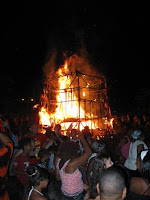If you are planning a trip to Cuba, you would do best
by planning your visit during a festival. Holidays and festivals in Cuba are
best divided between national holidays and cultural festivals. Many of the
national holidays serve the purpose of commemorating events from the revolution,
but I want to focus on the cultural festivals here. Many of Cuba’s cultural
festivals arose out of the traditions of Catholicism and Santeria.
Some of the most popular festivals include:
Cubadisco Festival
Carnaval
Fire Festival in Santiago de Cuba
Parranda of the Remedios in Villa Clara
 Cubadisco Festival
Cubadisco Festival
Late-May
The Cubadisco Festival is a weeklong music festival in Havana, dedicated to celebrating Cuban music.Taking place in May, many people compare it to the Grammy award festival. Last year’s award ceremony was dedicated to the 500th anniversary of the founding of Havana and the 100th birthday of famed Cuban singer, Benny More. Some of the 2019 award winners include Patricio Amaro for pop music, Jamnael Casanova for electronic music, and Horacio Hernandez for jazz.
Carnaval
July 18-27
Cuban Carnival is a bit different from Carnival in the rest of the Caribbean. The primary difference is that Carnival does not mark the beginning of Lent in Cuba. Instead, Carnival de Santiago de Cuba evolved from a weeklong celebration that is believed to have evolved from the feast day of Santiago (St. James), now the festival commemorates Castro’s assault on the Moncada barracks. While the timing of Carnaval is different, the festivities look very similar to other Carnaval celebrations. People often wear large extravagant headdresses and have parades in the streets, complete with copious amounts of alcohol.
Fire Festival
July 3-9
The Fire Festival in Santiago is a celebration of all Caribbean cultures. The three-day festival invites delegations from the other Caribbean islands and sees multiple symposiums, parties, and theatrical events celebrating life in the Caribbean. The festival is kicked off with an event known as the “Desfile de la Serpiente” (the Snake Parade), this parade is a journey that works its way down Aguliera street from the Plaza de Martes to the Parque de Cespedes. Along the route, participants will be able to see the foreign delegations singing national songs and preforming national dances while hoisting their flags. On July 9th, the last day of the festival, everyone will gather at Michelson Boulevard to witness the Burning of the Devil, a tradition very similar to the Burning Man festival in the States.
Parranda de la Remedios
December 16-26
La Parranda de la Remedios is believed to be the oldest celebration in Cuba. The celebration started when the head priest of the Grand Cathedral of Remedios in the 18th century told a group of children to run through the streets making noise to remind people of midnight mass leading up to Christmas and the traditions grew. In 1871, a tradition started where the church bells would ring at 9, this was to be a signal for two rival neighborhoods, San Salvador and El Carmen, to present their parades and see which neighborhood had the better showing. Now the festival has evolved into a weeklong street party with music and fireworks.
References:
“7 Popular Traditions and Celebrations in Cuba.” BandBCuba.com, 21 July 2019, www.bandbcuba.com/blog/traditions/7-popular-traditions-and-celebrations-in-cuba/.
“Carnaval in Santiago De Cuba.” Cubano Cuba, www.cubanocuba.com/carnaval-in-santiago-de-cuba/.
“CubaDisco Event in Havana, Cuba. International Disco Fair.” Cuban Travel Business, 7 Feb. 2019, www.cuba-culture.com/cubadisco/.
“The Parrandas De Remedios Christmas Festival in Cuba.” Las Parrandas De Remedios Christmas Festival in Cuba, Big Planet Adventures, www.cubagrouptour.com/information/cuba/events/parrandas/remedios-christmas-festival-cuba.html.
Robinson, Circles. “The Fire Festival of Santiago De Cuba.” Havana Times, 5 Sept. 2011, havanatimes.org/features/the-fire-festival-of-santiago-de-cuba/.



All 5 requirements were met. I really liked your layout this week of how the different festivals are separated into paragraphs. Nice hyperlinks and citations.
ReplyDelete